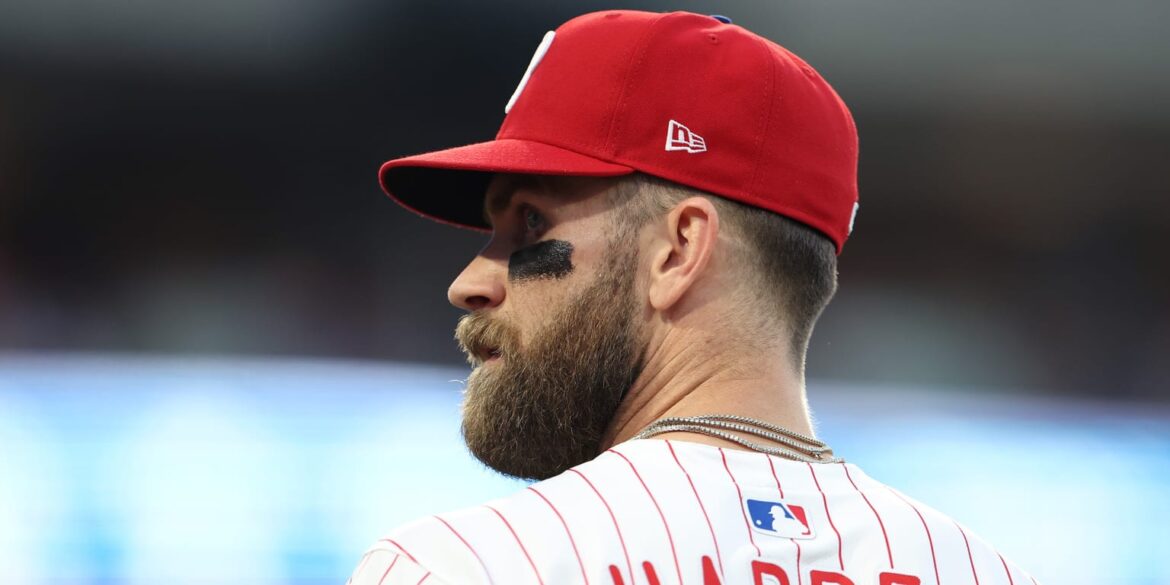PHILADELPHIA — What will it take for Bryce Harper to be elite again?
Among all of the questions facing the Phillies in this pivotal offseason, that wasn’t expected to be one of them. Yet that became quite the topic of conversation after Phils president of baseball operations Dave Dombrowski wondered aloud at his year-end press conference whether Harper could return to “elite” status or not.
“Give Bryce Harper more pitches to hit,” Boras said, “and the metrics speak that all that they want will be delivered.”
Sure, getting better pitches is part of it — but that’s also not exactly a new development for Harper.
So what would it really take for Harper to get back to being, well, elite? Let’s dive in a little deeper.
Chase less
This one sounds simple, but there are layers to it.
First, let’s talk a little more about that lack of good pitches to hit. To that point, just 43% of the pitches Harper saw this past season were in the strike zone — the lowest rate out of 532 players (minimum 200 pitches).
The instinct is to chalk that up to Harper’s lack of protection in the lineup. With Harper mostly hitting third this past season, Phillies cleanup hitters combined for a .720 OPS (20th in MLB).
That said, Harper’s in-zone rate in 2025 was actually slightly higher than his first six seasons in Philadelphia, when only 42.6% of the pitches he saw were in the strike zone. Only the free-swinging Javier Báez had a lower in-zone rate from 2019-24.
The difference this past year is that Harper was a lot less patient.
He swung at the first pitch 54.1% of the time. That was not only well above his career average of 42.6%, but — among the 309 players with at least 250 plate appearances last season — the only player across the Majors to swing at the first pitch more often was teammate Nick Castellanos (56.5%).
Beyond that, Harper had a chase rate of 35.6% — just a tick shy of his career-high 35.7% in 2022.
In his 2021 NL MVP-winning season, Harper had a chase rate of just 24.8%. In his other MVP season with the Nationals in 2015, his chase rate was 25.6% — and that was despite only 40.7% of the pitches he saw being in the zone.
Perhaps Harper chased more in 2025 because he felt obligated to come through given the struggles of those hitting behind him? Perhaps he would chase less in ’26 with more protection?
Do more damage on hittable pitches
Regardless of Harper’s chase rate, he has always been the type of hitter to make opposing pitchers pay for just about any mistake — but that wasn’t the case in 2025.
Harper hit .296 with a .597 expected slugging percentage on pitches in the zone last season. While respectable, it was a far cry from his 2021 MVP season, when he hit .346 with a .765 xSLG on in-zone pitches.
But now consider what Harper did against pitches that were really hittable.
From 2019-24, Harper hit .384 with an .837 slugging percentage against pitches over the heart of the plate. Only Shohei Ohtani and Aaron Judge had a higher slugging percentage on such pitches.
In 2025, though, Harper hit just .303 with a .652 slugging percentage on pitches over the heart of the plate — still good, but not quite “elite.”
Clutch hits
Of course, any debate about a player being “elite” always involves some level of perception. In Harper’s case, his ability to come through in big moments has always been part of his mystique.
Over his first six seasons with the Phillies from 2019-24, Harper had a ridiculous 1.197 OPS with two outs and runners in scoring position — easily the best in MLB. And when the lights were the brightest, he also led all qualified hitters with a 1.153 OPS in the postseason during that span.
But this past season, Harper hit just .172 (10-for-58) with a .575 OPS with runners in scoring position and two outs. He didn’t hit a single home run in that situation — the first time he’s done that since 2014.
Then, Harper went just 3-for-15 (.200) with a .600 OPS in the Phillies’ brief postseason run.
Whether Harper’s production will return to those previous levels next season remains to be seen, but regardless of what happens this offseason, he likely shouldn’t plan on seeing more strikes next year.
The key will be laying off a few more pitches out of the zone — and what he does to the rare mistakes over the plate.
